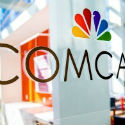Comcast Business sizes up symmetrical speed options, home SD-WAN play
The pandemic may have slowed the overall rate of growth of cable business services, but it has also presented opportunities to ramp up new products and services, says Comcast Business exec Bob Victor.

CABLE NEXT-GEN DIGITAL SYMPOSIUM – While the pandemic has slowed the rate of revenue growth for cable business services, it has also presented opportunities for companies like Comcast Business to creatively develop and ramp up new apps and services as customers pivoted to support a much bigger remote workforce.
"This issue of remote work ... has really come to the fore," Bob Victor, senior vice president of product management at Comcast Business, said Tuesday. He spoke during a keynote that kicked off day one of a Light Reading-hosted online conference focusing on the cable business services market.
Of note, video conferencing is "really taking off" and unified communications has likewise become a more central part of a new normal spawned by COVID-19, he said.
To help relieve some of the pressure on the upstream portion of the hybrid coax/fiber (HFC) network, Comcast Business responded with a new work-from-home product that provides a second modem/gateway that can be charged back to the business and does not compete for upstream bandwidth with the rest of the house.
From a corporate IT perspective, some customers are also looking to extend the wide area network. While SD-WAN had been taking off in its own right prior to the pandemic, "the home has become a district and necessary node on the corporate network," Victor said.
That situation has caused Comcast Business to explore and start to develop an SD-WAN product tailored for home workers powered by lower-cost consumer premises equipment (CPE). Victor said Comcast Business, which uses a software-defined network platform called ActiveCore, has been investing in a home SD-WAN option and has been developing that engineering in-house and in tandem with partner Versa Networks.
"We'll be shortly launching a product in this area," he said.
With an eye on improved upstream capabilities, Victor said Comcast Business is also gearing up for symmetrical data trials that could be used both as a replacement for MPLS networks and on HFC plant connecting remote workers and people operating small businesses at home.
Unified communications is another "big push" for Comcast Business during the pandemic, Victor said. Of note, the company is starting to push a new, upgraded application of its voice product for multi-site customers. It is standardizing on the Blueface platform (Comcast acquired Blueface in January 2020), which is on a path to integrate with major video conferencing platforms.
Comcast Business has also emphasized new security options to help fend off things like DDoS attacks as commercial customers moved to support a much larger remote workforce. "Securing the network and securing the employees at home has become even more critical," Victor said.
The pandemic has also amplified the need for self-install kits, automation tools and the use of digital sales and support systems.
"A lot of our customers now in this environment prefer to do things themselves, and that creates efficiencies for us," Victor said. "The more we can do on our digital platforms, the better."
Market snapshot
Even before the pandemic struck the market in 2020, cable business services revenue growth had been slowing, in part because the numbers had gotten so large.
US cable commercial revenues were up 8% in 2019, down from 10% in 2018, and the growth rate was down much further through the first half of 2020 because of pandemic pressures on business owners, Alan Breznick, cable/video practice leader at Light Reading, explained in his opening comments.
"The growth rate has slowed down; it hasn't quite stopped yet," Breznick said, noting that he's eagerly awaiting Q3 2020 numbers to see if operators saw a rebound in that period as the economy started to open up.
"It is true that revenue has slowed, but to put that in perspective, the cable operators are still very much taking share from the traditional telcos," Victor said.
The business services segment now represents a $20 billion market for the US cable industry, with the bulk of it still coming from small business customers alongside some growth among midsized and enterprise customers, he said.
Light Reading will have more coverage to come from Tuesday's event. Day 2 of Light Reading's Cable Next-Gen Digital Symposium, with a focus on new network architectures, will get underway Thursday, October 8 at 11:00 a.m. ET.
Related posts:
— Jeff Baumgartner, Senior Editor, Light Reading
About the Author(s)
You May Also Like




_International_Software_Products.jpeg?width=300&auto=webp&quality=80&disable=upscale)







